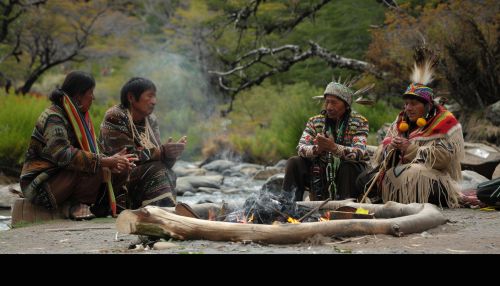Mapudungun language: Difference between revisions
(Created page with "== Introduction == '''Mapudungun''' is the language of the Mapuche people, indigenous to south-central Chile and southwestern Argentina. It is a member of the Araucanian language family, which is considered a language isolate. Mapudungun, also known as Mapuche or Mapuzugun, is a polysynthetic language with a rich morphological structure and a complex system of verbal inflection. == Phonology == === Consonants === Mapudungun has a relatively smal...") |
No edit summary |
||
| Line 59: | Line 59: | ||
* [[Language policy]] | * [[Language policy]] | ||
[[Image:Detail-91475.jpg|thumb|center|Mapuche people performing a traditional ceremony in a natural setting.|class=only_on_mobile]] | |||
[[Image:Detail-91476.jpg|thumb|center|Mapuche people performing a traditional ceremony in a natural setting.|class=only_on_desktop]] | |||
== References == | == References == | ||
Latest revision as of 02:41, 21 June 2024
Introduction
Mapudungun is the language of the Mapuche people, indigenous to south-central Chile and southwestern Argentina. It is a member of the Araucanian language family, which is considered a language isolate. Mapudungun, also known as Mapuche or Mapuzugun, is a polysynthetic language with a rich morphological structure and a complex system of verbal inflection.
Phonology
Consonants
Mapudungun has a relatively small consonant inventory, consisting of stops, fricatives, nasals, a lateral, and approximants. The stops include both voiced and voiceless varieties, and the language features a series of affricates. Notably, Mapudungun lacks the bilabial fricative /f/, which is uncommon among world languages.
Vowels
The vowel system in Mapudungun is composed of five vowels: /a/, /e/, /i/, /o/, and /u/. These vowels can occur in both short and long forms, and vowel length can be phonemic, meaning it can change the meaning of a word.
Stress and Intonation
Stress in Mapudungun is generally penultimate, falling on the second-to-last syllable of a word. However, stress can shift in certain morphological contexts. Intonation patterns in Mapudungun are used to distinguish between different types of sentences, such as declarative, interrogative, and imperative.
Morphology
Nouns
Nouns in Mapudungun are inflected for number, case, and possession. The language distinguishes between singular and plural forms, and there are several cases, including nominative, accusative, and genitive. Possession is marked by a set of possessive prefixes that agree with the person and number of the possessor.
Verbs
Verbs in Mapudungun are highly inflected and can carry a significant amount of grammatical information. Verbal morphology includes markers for tense, aspect, mood, person, and number. The language also employs a system of applicative and causative constructions, which allow for the addition of arguments to the verb.
Pronouns
Mapudungun has a rich system of personal pronouns, which distinguish between first, second, and third person, as well as singular, dual, and plural number. There are also inclusive and exclusive forms for the first person plural.
Syntax
Word Order
The basic word order in Mapudungun is Subject-Object-Verb (SOV), although variations can occur due to topicalization and focus. The language allows for a relatively free word order, with syntactic roles often indicated by case markers rather than word position.
Clause Structure
Mapudungun clauses typically consist of a subject, an object, and a verb. Subordinate clauses are introduced by conjunctions, and relative clauses follow the noun they modify. The language also employs a variety of sentence types, including declarative, interrogative, and imperative.
Semantics
Lexical Semantics
The lexicon of Mapudungun is rich and diverse, reflecting the cultural and environmental context of the Mapuche people. Many words are related to the natural world, traditional practices, and social organization. The language also has a number of loanwords from Spanish, reflecting historical contact and influence.
Pragmatics
Pragmatic aspects of Mapudungun include the use of honorifics and politeness strategies. The language has a system of verbal suffixes that indicate respect and social hierarchy. Additionally, discourse markers and particles play an important role in structuring conversation and indicating speaker attitude.
Sociolinguistics
Language Vitality
Mapudungun is considered an endangered language, with a declining number of speakers. Efforts are being made to revitalize the language through educational programs, community initiatives, and media production. The language is taught in some schools and used in cultural events and ceremonies.
Bilingualism and Language Contact
Many Mapudungun speakers are bilingual in Spanish, and language contact has led to significant borrowing and code-switching. This bilingualism has both positive and negative effects on the vitality of Mapudungun, as it can facilitate communication but also contribute to language shift.
Language Policy
Language policy in Chile and Argentina has historically marginalized indigenous languages, including Mapudungun. However, recent legal and educational reforms have aimed to promote and protect these languages. The recognition of Mapudungun as a co-official language in certain regions is a step towards linguistic and cultural preservation.
Writing System
Mapudungun has traditionally been an oral language, but several writing systems have been developed over time. The most widely used system today is the Raguileo Alphabet, which was created in the 1980s. This alphabet uses Latin script and includes special characters to represent sounds unique to Mapudungun.
Cultural Significance
Mapudungun is not only a means of communication but also a key component of Mapuche identity and cultural heritage. The language is used in traditional ceremonies, storytelling, and music. It also plays a role in the transmission of indigenous knowledge and worldview.
See Also


